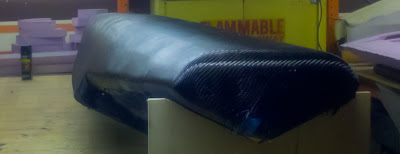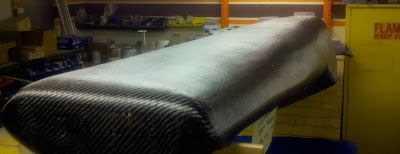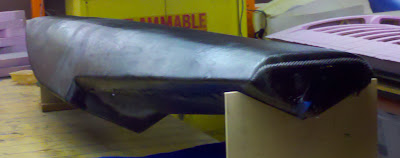Please note: James' blog has moved to a Wordpress site. To access it, please visit
http://jameswiebe.wordpress.com/. All posts have been transferred to the new site, and all new posts will only be accessible via Wordpress. Thank you for your interest!
Hey Eugene:
While nosing around in the Belite shop earlier this evening, I noticed that they were preparing to pull the wraps off their new aircraft floats. It is clear they plan to announce at Oshkosh: but at what price?
I was able to gather some basic technical information, and also take some pictures, which I've pasted below.
The note said:
* 19 pounds, 13 ounces as shown (still missing a couple of attachment hardware fittings)
* Up to 3 layers of Carbon Fiber cloth overall
* Carbon Fiber over foam construction
* Pre-cut foam pieces
* Inexpensive
* Final all up weight estimated at 22 pounds (straight); 35 pounds (amphibious)
* Superior to earlier Belite and other aluminum floats (much easier to construct; inherently more waterproof due to foam design)
* 620 pound maximum gross weight
* Belite will be selling float kits for a special price during Oshkosh and shortly thereafter
These are clearly a significant product offering for experimental aircraft... looks to be a game changer for anyone who wants to fly off water. If Belite has truly pulled off a carbon fiber composite float which sells for a reasonable $ amount... wow. That will be so cool.
The float in the following pictures was not quite complete. It needed some sanding and some other stuff, but it sure looked like a float to me.
Your Friend,
Billy Bob.
P.S.: Have a look at these pictures:
 |
| Carbon Fiber Float from Belite |
 |
| Carbon Fiber Float from Belite |
 |
| Carbon Fiber Float from Belite |
 |
| Carbon Fiber Float from Belite |
 |
| Carbon Fiber Float from Belite |
Special note to Mickey: thank you for encouraging me to think outside the box.








